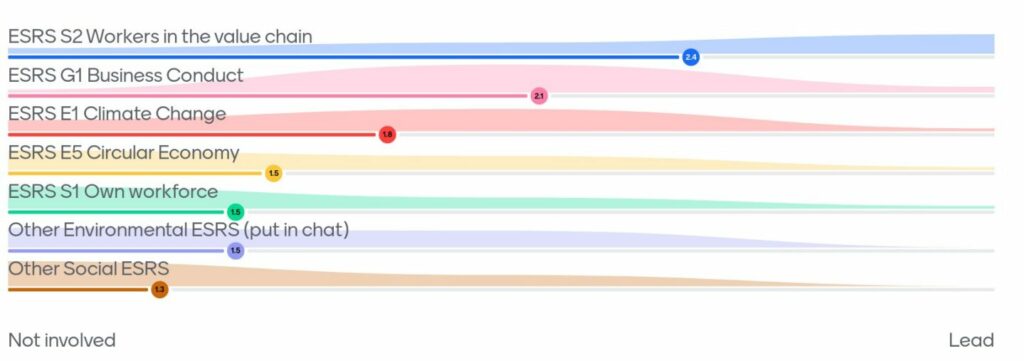It’s the word in everyone’s mouth this year, the topic of every webinar, the pebble in everyone’s shoe – the infamous Corporate Sustainability Reporting Directive, or CSRD, the acronym that sends chills down the spine. Here are a few points to understand the impact of CSRD on Procurement.
Table of Contents
What is the CSRD?
To summarize, the CSRD is a corporate reporting obligation part of the EU Green Deal that requires companies to disclose non-financial information in a standard way. The aim is to provide reliable and comparable information needed by investors and other stakeholders. At the core of the CSRD is the double materiality analysis (DMA) which determines which European Sustainability Reporting Standards (ESRS) companies will need to report on, and which datapoints within the ESRS.
How does Procurement contribute to CSRD?
Procurement is a key contributor to the CSRD! Not only is the concept of value chain integrated in every ESRS, but there are also at least two ESRS – S2 Workers in the Value Chain and G1 Business Conduct – that directly involve Procurement.
In a recent VDA by TOLSON session that I moderated, I asked participants to share to which ESRS they contribute. The results show that when the project is set up in a way in which the Group CSR delegates an ESRS to a function:
- S2 is consistently led by Procurement
- G1 there is active participation
- S1 there is rarely involvement
- Environmental ESRS there is contribution of varying degree
- Social ESRS (other than S2) no involvement

What are best practices for Procurement to keep in mind?
In the immediate future, the main concern of Procurement is compliance with CSRD, which entails data collection and reporting on material sustainability matters.
- Very concretely, this means you should see CSRD as a project and assign one person to own the project. This person should deep dive into the ESRS that are material for Procurement, the S2 and G1 in priority, and understand what the CSRD is asking. Even if the project is being fully managed by Group Sustainability or Group Finance (or in some cases Sustainable Finance), I strongly recommend having a Procurement team member who is familiar with CSRD requirements as this is an annual process that has clear implications on procurement.
- Next, the concept of materiality should always be kept in mind. You don’t have to cover everything, prioritize datapoints based on materiality and prioritize efforts on bridging gaps based on materiality.
- Third, note that CSRD is a journey. This sentiment is echoed by auditors, investors and rating agencies alike. If you are missing data, then be transparent and highlight what actions you are putting in place to provide this information.
- Fourth, consider the internal controls to ensure that the data is reliable, just as is the case with financial reporting. I was recently talking to some peers on how ESG data is a ripe candidate for fraud. Here, start with quantitative information first and ask questions like: How have I ensured there is no error in calculations of scopes? How have I ensured the data is updated? How have I ensured the data is accurate (no risk of fraud, for example by supplier)?
- Finally, reporting is important but even more so is implementing actions. Be constantly thinking of what concrete actions you can implement to improve positive impacts and reduce negative impacts.
What are the more long-term impacts of CSRD on Procurement?
Beyond reporting, the CSRD will also bring some fundamental changes. Procurement teams can already anticipate four impacts:
1/ Require greater transparency from suppliers
Firstly, all 12 ESRS include the concept of value chain. You can also take a look at the list of datapoints published by EFRAG. Most of this data is not in the hands of Procurement today, and that’s fine, the CSRD is an iterative process. But Procurement should be anticipating how to bridge gaps by having suppliers disclose further on topics such as climate change, pollution, water use, health and safety, labour practices in their own value chain, business conduct, etc…
Use the results of your double materiality assessment and gap analysis to prioritize what further information you will have to collect from your suppliers moving forward.
2/ Serve as a tool for risk management
Assessing impacts, risks, and opportunities of each sustainability matter is a key feature of the CSRD through the double materiality assessment. Organizations may find that there are material topics which they had not considered prior, a good example of this is biodiversity topics.
I know of some companies that are using this exercise to redo their risk mapping by taking into consideration new risks.
It is also an opportunity to review procurement policies and update them to ensure that all material risks are covered. An example I’ve seen is reviewing your supplier code of conduct to incorporate material sustainability matters.
3/ Shift demand towards more sustainable products and services
This is the continuation of a trend of having sustainability criteria play a more important role in tenders. The weight of sustainability criteria is usually around 10 -15% but this number might rise as ESG criteria becomes more important.
4/ Leverage opportunities to increase positive impacts
While it’s easy to look at CSRD and only see risks, the objective of the disclosure framework is also to highlight opportunities. For example, boosting worker’s engagement processes, supplier diversity, increased access to recycled raw materials. While companies have made good progress on risk identification and mitigation, exploring opportunities to increase positive impacts remains less mature. But I’d keep this key piece in mind when defining action plans!
So where are you on your Procurement CSRD journey and what are the questions you’re asking yourself on how others are doing?
If you want to optimize your Procurement strategy, join the VDA benchmarking community: the community that brings together professionals working in the field of Procurement to progress together on common challenges.



